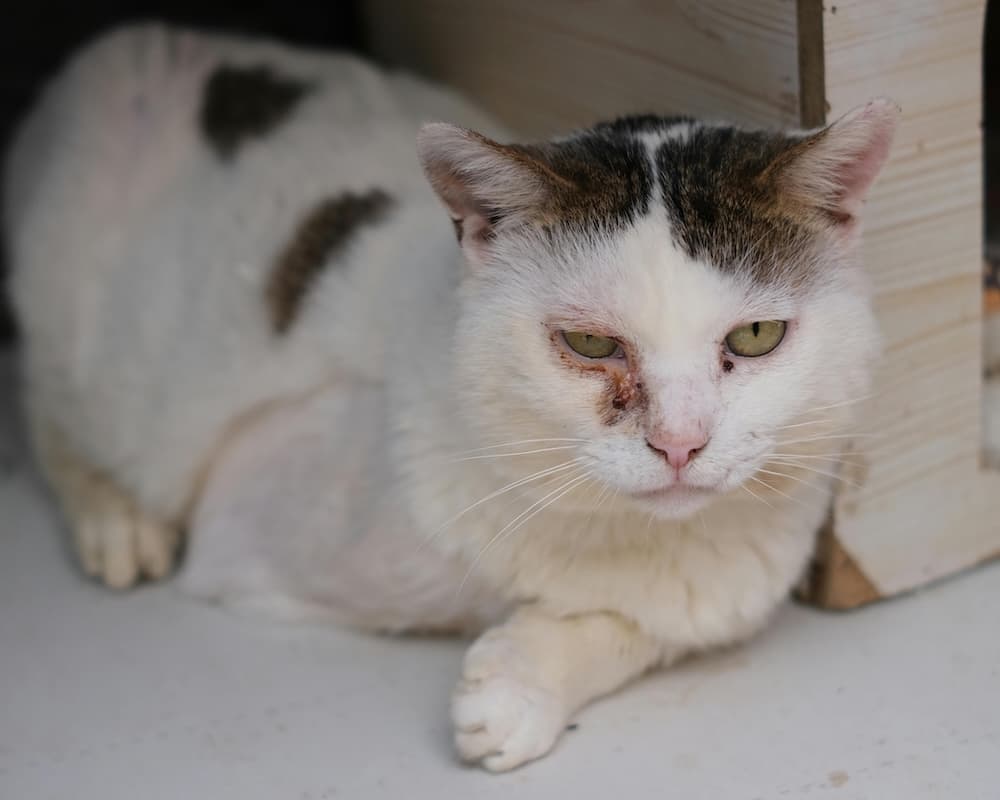
Upper Respiratory Infection (Cat Cold)

Our guide has been authored by qualified veterinarians, but should not be taken as substitute for medical advice or professional veterinary consultation. If your pet displays any unusual symptoms, we strongly advise seeking guidance from a veterinarian
Understanding Upper Respiratory Infection (Cat Cold) in cats
Upper respiratory infections are common in cats, especially during the early kitten stage (up to six months of age). These infections are mostly viral, but bacteria can also be involved in some cases, either as the primary culprit or as a secondary one. Vaccinated cats usually experience the disease with a mild severity level, while unvaccinated cats (including very young ones and cats with a weakened immune system) are at risk of severe illness with serious eye damage that can lead to blindness and breathing difficulties.
Upper Respiratory Infection (Cat Cold)'s Causes: Uncovering Triggers
- As we’ve already mentioned, the disease is typically caused by a virus, such as the feline herpes virus (FHV) or calicivirus (FCV).
- Certain bacteria may cause or contribute to existing infections, including Chlamydia, Bordetella, and Mycoplasma.
These highly contagious pathogens can spread in multiple ways:
- Direct contact is most common and can occur among littermates or from mother to kitten during the first few weeks of life. The disease is transmitted via nasal discharge, eye discharge or saliva.
- Indirect transmission occurs via contaminated objects (sniffing the same object, sharing water or food bowls, cages, or beds).
Certain factors might complicate the disease, making it significantly more dangerous to cats:
- Age: Young, unvaccinated kittens may suffer a more severe form of the disease.
- Existing conditions: Other diseases, especially ones that compromise the immune system- including feline AIDS (FIV) or feline leukemia (FeLV)- lead to more severe respiratory infections.
 Recognizing Upper Respiratory Infection (Cat Cold): Signs and Symptoms
Recognizing Upper Respiratory Infection (Cat Cold): Signs and Symptoms
- Frequent sneezing with nasal discharge or congestion
- Partial or complete closure of the eyelids
- Eye discharge and cloudiness to the cornea
- Swelling of the eyelids and conjunctiva
- Sores on the tongue and around the mouth
- Coughing
- Wheezing during breathing
- Overall lethargy and loss of appetite
 Upper Respiratory Infection (Cat Cold) Diagnosis: How it's Identified
Upper Respiratory Infection (Cat Cold) Diagnosis: How it's Identified
Diagnosis is based on the cat’s clinical signs and a medical examination, as well as any known possible exposure history. In some cases, specific tests that isolate the causative agents like PCR or culture are added, but they are not commonly performed for first time upper respiratory infections.
 Treating Upper Respiratory Infection (Cat Cold): Options and Approaches
Treating Upper Respiratory Infection (Cat Cold): Options and Approaches
- Approximately 90% of upper respiratory infections in cats are viral, out of which over 90% can be prevented by following vaccination recommendations. If a vaccinated animal contracts these diseases, it’s very mild in most cases.
- In settings with multiple cats, such as animal shelters, good hygiene must be practiced and animals showing signs of illness should be isolated to reduce exposure to others.
- If the cat displays mild symptoms, like for example nasal discharge alone, treatment might not be required at all, especially in a vaccinated cat. At-risk cats, on the other hand, should receive comprehensive care to prevent fatal complications.
- If feline herpes virus is suspected, antiviral medications may be administered orally and/or directly to the eye.
- Antibiotic eye ointment can help treat conjunctivitis caused primarily by Chlamydia-related infections. This may be recommended in cases of suspected viral conjunctivitis, as well to prevent secondary bacterial infection.
- Systemic antibiotics may be offered in cases of suspected Mycoplasma or other bacterial infections.
- Supportive fluid administration and appetite stimulants may be necessary for cats who are not eating or drinking adequately.
- Special orally administered gels can help with ulcers on the tongue or gums.
Upper Respiratory Infection (Cat Cold): Surprising Facts

Many people might be concerned when herpes or chlamydia are mentioned, but it’s important to note that these pathogens are specific to cats and are not contagious to humans.

When a cat has herpes, it can be treated with medication to help symptoms subside, but herpes is not curable. It stays dormant in the cat’s system and these carrier cats may flare up, due to stress, illnesses, or immune system problems.

The vaccine protects cats against the most common upper respiratory diseases: herpes and calicivirus. Some types of the vaccine also protect against Chlamydia. These vaccines are given in a series to kittens at 8-16 weeks old and then boostered every 1 to 3 years, depending on the specific cat’s lifestyle and risk level.
 Vet's Tip: Dealing with Upper Respiratory Infection (Cat Cold)
Vet's Tip: Dealing with Upper Respiratory Infection (Cat Cold)
The disease is potentially life-threatening for young kittens under 2 months, who can deteriorate rapidly due to dehydration or trouble breathing. If your kitten shows signs of nasal and eye discharge or redness and drooling, don’t waste time- visit a clinic immediately.




Price Tag

Latest in Research and Treatments
Viral infections like herpes are especially challenging in unvaccinated cats, but there’s no point in vaccinating during the illness since it takes several days for the body to produce antibodies. Recent promising studies focus on orally administered and injected immunomodulators that generate a quick immune response with significant healing potential. Some of these breakthrough treatments are already used in veterinary medicine in some regions.
Did you know?
Enrolling in Animalia Pet Insurance
while your pet is healthy is a wise decision.
Waiting until a disease develops means it won't be covered.






